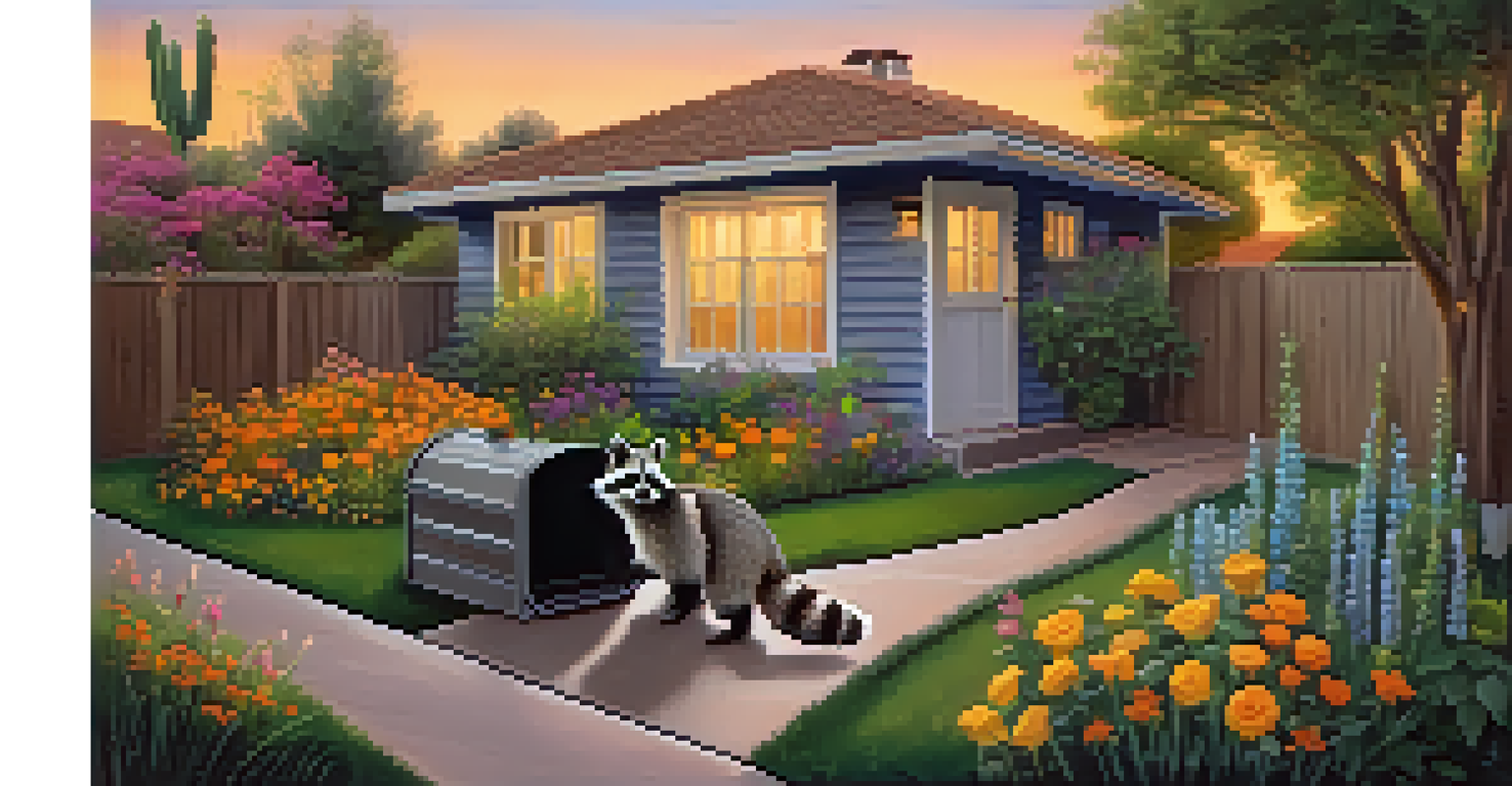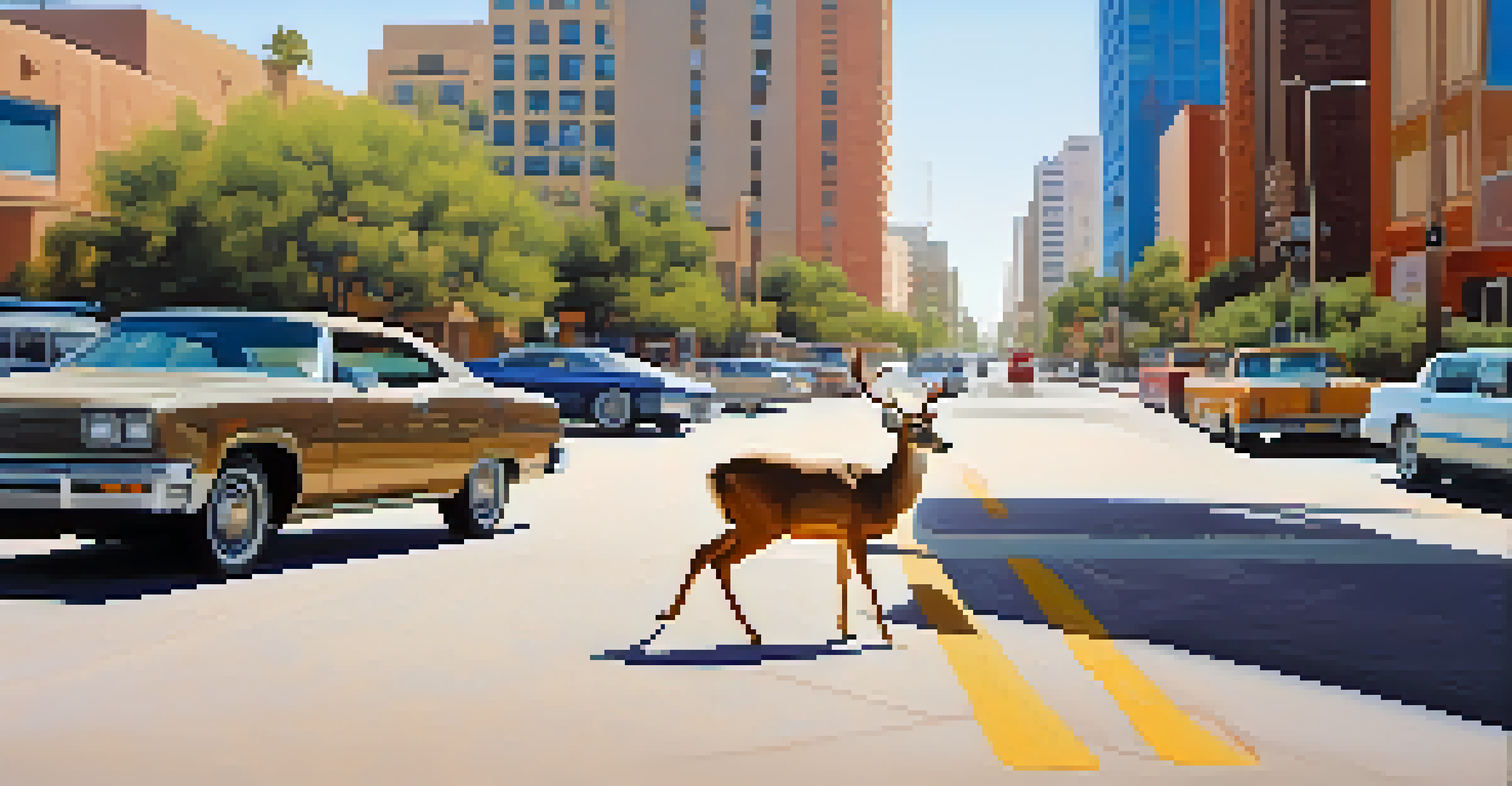Human-Wildlife Conflicts in Arizona's Urban Environments

Understanding Human-Wildlife Conflicts in Arizona
Human-wildlife conflicts occur when animals and people interact in ways that lead to negative consequences for one or both parties. In Arizona's urban environments, this can manifest in various forms, such as animals scavenging for food in neighborhoods or damaging property. As urban areas expand into natural habitats, the likelihood of these conflicts increases, highlighting the need for effective management strategies.
The clearest way into the Universe is through a forest wilderness.
Wildlife species such as coyotes, deer, and even javelinas are increasingly spotted in residential areas, drawn in by food sources left out or accessible. This shift can create safety concerns for residents, as these animals may become more aggressive when they lose their fear of humans. Understanding the motivations behind these conflicts is crucial in addressing them effectively.
Moreover, these interactions can have broader ecological impacts, such as altering animal behavior and population dynamics. For instance, if a food source in an urban area becomes too reliable, it might encourage more wildlife to inhabit those spaces, leading to increased competition among species. By studying these patterns, we can develop targeted solutions that benefit both wildlife and communities.
Common Species Involved in Urban Conflicts
In Arizona, several wildlife species frequently find themselves entangled in human conflicts, including coyotes, raccoons, and even the occasional bobcat. These animals are highly adaptable, making cities an attractive environment for them, especially when food is readily available. For example, coyotes are known to scavenge through trash and forage for pet food left outside, which can lead to encounters with residents.

Raccoons, often seen as cute and harmless, can also cause issues when they rummage through garbage or invade attics. Their dexterous paws allow them to open containers that most people think are secure, leading to messy situations. Understanding their behavior can help residents take preventative measures, such as securing trash bins or removing outdoor pet food.
Rising Human-Wildlife Conflicts
As urban areas expand into wildlife habitats, interactions between humans and animals are increasing, leading to potential safety concerns.
Even larger animals, like deer, have been spotted wandering into urban areas, sometimes causing traffic accidents or property damage. Their presence is a reminder that as urban areas grow, wildlife will adapt and venture closer to human habitats, necessitating a proactive approach to managing these encounters.
The Impact of Urbanization on Wildlife Behavior
Urbanization dramatically alters the natural habitat, affecting wildlife behavior and movement patterns. As cities expand, the natural landscapes that animals rely on for food and shelter are replaced by roads and buildings, pushing wildlife into smaller, fragmented areas. This can lead to increased competition for resources, making urban areas seem like a viable option for survival.
In nature, nothing exists alone.
Animals that thrive in urban environments often exhibit behaviors that are not typically seen in their wild counterparts. For instance, some species become more nocturnal, taking advantage of quieter nighttime hours to search for food. In contrast, others may become more bold and venture out during the day, leading to more frequent encounters with humans.
Understanding these behavioral changes is key to mitigating conflicts. By recognizing that wildlife is simply trying to adapt to their changing environment, we can implement strategies that reduce negative interactions, like creating wildlife corridors or green spaces that allow animals to navigate urban landscapes more safely.
Preventative Measures for Residents
One of the most effective ways to minimize human-wildlife conflicts is through proactive measures taken by residents. Simple actions like securing trash cans, removing pet food from outdoor areas, and keeping barbecue grills clean can discourage wildlife from venturing too close. It's all about making your home less appealing to these animals, thus reducing the likelihood of encounters.
Additionally, residents can incorporate wildlife-proof fencing or barriers to protect gardens and landscaping from browsing animals. This not only helps in keeping plants safe but also creates a clear boundary that wildlife may learn to recognize. Such measures can foster a more harmonious relationship between humans and local wildlife.
Proactive Measures for Residents
Residents can reduce human-wildlife conflicts by securing food sources and implementing wildlife-proof barriers around their homes.
Education also plays a crucial role in prevention. Communities can benefit from workshops and resources that teach residents about local wildlife behavior, encouraging them to coexist peacefully and responsibly. Being informed empowers individuals to take action, creating a safer environment for both people and animals.
Community Involvement in Wildlife Management
Community involvement is essential in addressing human-wildlife conflicts effectively. Local organizations and wildlife agencies can collaborate with residents to foster a sense of stewardship and responsibility towards local wildlife. This can include initiatives like neighborhood clean-up days or wildlife monitoring programs that engage the community in active participation.
Educating community members about the importance of wildlife conservation can shift perspectives and encourage more compassionate interactions. For example, knowing that coyotes play a vital role in controlling rodent populations can help residents appreciate their presence rather than viewing them solely as pests.
By creating a community-focused approach to wildlife management, residents can share knowledge and experiences, fostering a supportive environment for both people and animals. This collective effort can lead to sustainable solutions that benefit the entire community, ensuring that wildlife and humans can coexist harmoniously.
The Role of Local Wildlife Agencies
Local wildlife agencies play a pivotal role in managing human-wildlife conflicts, providing resources and expertise to communities facing these challenges. They often conduct research to understand wildlife behaviors and the impacts of urbanization, which can inform best practices for residents. By staying informed about local wildlife populations, agencies can offer timely advice and interventions.
In addition to educational resources, these agencies may conduct outreach programs to engage the community in wildlife conservation efforts. This can include workshops on coexisting with wildlife or training sessions on how to safely deal with encounters. The goal is to empower residents with the knowledge and tools they need to mitigate conflicts effectively.
Community Engagement is Key
Involving the community in wildlife management fosters a sense of responsibility and leads to sustainable solutions for coexistence.
Furthermore, wildlife agencies often collaborate with local governments to develop policies and strategies that address human-wildlife conflicts on a larger scale. This partnership ensures that wildlife management is not only reactive but also proactive, creating a framework for sustainable coexistence in urban areas.
Looking Ahead: Coexisting with Urban Wildlife
The future of urban wildlife in Arizona will depend on our ability to adapt and find ways to coexist sustainably. As cities continue to grow, it’s crucial to recognize that wildlife is an integral part of our ecosystem, offering benefits that often go unnoticed. From pest control to enriching our natural landscapes, wildlife plays a vital role in maintaining ecological balance.
Promoting awareness and understanding of wildlife behavior can help bridge the gap between humans and animals. By fostering a culture of respect and coexistence, we can create urban environments where both people and wildlife thrive. This involves not only reducing conflicts but also celebrating the beauty and diversity of the wildlife that shares our spaces.

Ultimately, a collaborative approach that includes residents, community organizations, and wildlife agencies will pave the way for a more harmonious relationship with urban wildlife. Together, we can ensure that future generations will continue to enjoy the wonder of wildlife in their neighborhoods, creating a lasting legacy of coexistence.